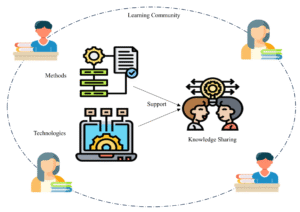In today’s fast-paced digital landscape, businesses are constantly seeking ways to enhance their operations and stay ahead of the competition. One critical aspect often overlooked is channel synchronization. It’s not just a buzzword; it’s a strategic necessity that can make or break your channelsyncharma success in this interconnected world.
Imagine seamlessly aligning all your sales channels—online and offline—so they work together harmoniously. Picture having real-time data at your fingertips to inform decisions, streamline processes, and drive customer satisfaction. Channel synchronization isn’t merely about technology; it’s about creating an integrated experience for both your team and your customers.
Curious about how this powerful concept can transform your business? Let’s dive into what channel synchronization really means and why it matters now more than ever.
What is Channel Synchronization?
Channel synchronization refers to the seamless integration of various sales and communication channels within a business. This concept ensures that information, branding, and customer experiences are consistent across all platforms.
When customers engage with your brand—whether through a website, social media, or in-store—they expect uniformity. Channel synchronization allows businesses to meet these expectations by providing coherent messaging and service delivery.
It involves sharing data across different points of interaction. This means that if a customer makes an inquiry online, their preferences can be recognized at any subsequent touchpoint.
In essence, channel synchronization enhances operational efficiency while improving customer satisfaction by ensuring every interaction feels connected and personalized. This strategic approach empowers businesses to respond quickly to market changes while maintaining strong relationships with their audience.
The Importance of Channel Synchronization in Business
Channel synchronization is crucial for businesses aiming to create a seamless customer experience. When all channels—be it online, retail, or mobile—work in harmony, customers receive consistent messaging and service.
This consistency builds trust. Customers are more likely to engage with brands that provide uniform information across platforms. Discrepancies can lead to confusion and frustration, detracting from the overall brand experience.
Moreover, synchronized channels enhance operational efficiency. Teams can share data more effectively when systems align, leading to quicker decision-making and improved inventory management.
In today’s digital landscape, where consumer expectations are high, failing to synchronize channels can result in lost opportunities and revenue. Businesses must prioritize this aspect as they strive for growth and customer satisfaction in an increasingly competitive market.
Challenges in Achieving Channel Synchronization
Achieving channel synchronization is no easy feat. Businesses often face a variety of challenges that can hinder their progress.
One major obstacle is data inconsistency across different platforms. Discrepancies in inventory levels, pricing, or customer information lead to confusion and mistrust among teams.
Another challenge lies in technology integration. Many companies use disparate systems that don’t communicate effectively with one another. This creates silos, making it difficult to obtain a unified view of operations.
Cultural resistance also plays a significant role. Employees may be hesitant to adopt new processes or technologies due to fear of change or lack of training.
Maintaining open communication channels between departments can be tough. Misalignment on objectives can further complicate the synchronization process, leading to inefficiencies and lost opportunities for growth.

Strategies for Effective Channel Synchronization
Effective channel synchronization requires a multifaceted approach tailored to your business needs.
First, establish clear communication across all channels. This ensures that every team member understands the brand’s goals and messaging.
Next, implement integrated technology solutions. Using platforms that facilitate real-time data sharing can significantly enhance coordination among departments.
Regularly review performance metrics to identify gaps. Analyzing customer feedback and sales data helps refine strategies over time.
Encourage collaboration between teams. Cross-functional meetings foster innovative ideas and streamline processes for improved efficiency.
Invest in training programs. Empowering employees with the right skills enables them to adapt quickly to changes in market dynamics or consumer behavior.
By weaving these strategies into the fabric of your operations, you set the stage for seamless channel synchronization.
Tools and Technologies for Channel Synchronization
The landscape of channel synchronization is continually evolving, thanks to innovative tools and technologies. These resources streamline processes, ensuring consistent messaging across various platforms.
One standout category includes integrated software solutions that provide real-time analytics. They help businesses monitor performance metrics and customer interactions effectively. With data at their fingertips, companies can make informed decisions faster.
Automation tools also play a vital role in enhancing efficiency. By automating repetitive tasks such as inventory updates or pricing adjustments, teams can focus on strategic initiatives instead of mundane activities.
Cloud-based platforms are another game-changer in this space. They offer flexibility and scalability while facilitating seamless collaboration among remote teams. This adaptability ensures all stakeholders remain aligned with the latest developments in real time.
Artificial intelligence enhances personalization efforts within channels. AI-driven insights allow brands to tailor content to specific audiences, resulting in improved engagement and conversion rates.
Case Studies of Successful Channel Synchronization Implementation
One striking example of effective channel synchronization comes from a leading global retailer. By integrating their online and offline inventory systems, they reduced stock discrepancies by 30%. This change empowered customers to see real-time availability. As a result, foot traffic increased in stores.
Another noteworthy case is found in the tech industry. A major electronics brand aligned its distribution channels through an automated platform. This shift improved communication between suppliers and retailers. Order fulfillment times decreased significantly, enhancing customer satisfaction ratings.
In the travel sector, a well-known airline utilized synchronized booking systems across multiple platforms. Travelers experienced seamless transitions between apps and websites for flight changes or cancellations. The outcome? Higher loyalty scores among frequent flyers.
These examples showcase how strategic approaches to channel synchronization can drive tangible results across various industries.

Future Trends and Predictions for Channel Synchronization
The landscape of channel synchronization is evolving rapidly. With advancements in artificial intelligence, businesses can expect more personalized customer interactions across all channels. AI-driven analytics will enable brands to predict consumer behavior and adjust their strategies in real-time.
Moreover, the rise of omnichannel retailing signifies a shift toward seamless experiences. Customers want to interact with brands across various platforms without friction. Companies that prioritize integration between physical and digital channels will gain a competitive edge.
Blockchain technology may also play a role in enhancing transparency and trust among stakeholders. It could streamline supply chain processes, making it easier for companies to synchronize efforts efficiently.
As remote work becomes standard, communication tools must adapt to ensure teams remain aligned. The importance of real-time collaboration software cannot be understated; it’s crucial for maintaining synchronization amid diverse working environments.
Conclusion
Achieving effective channel synchronization is critical for businesses that want to thrive in today’s fast-paced market. With the right strategies and tools, organizations can align their channels seamlessly, enhancing customer experience and operational efficiency.
As we look ahead, the landscape of channel synchronization will continue to evolve. Embracing innovations like AI and machine learning will only amplify its importance. By staying informed about emerging trends and adapting accordingly, businesses can ensure they are not just keeping up but leading the way.
The journey toward seamless channel synchronization may present challenges, but with persistence and strategic planning, companies can reap substantial rewards. Investing in robust systems that facilitate real-time updates ensures that all channels operate cohesively.
Success lies in understanding that every touchpoint matters. Striving for harmony across platforms enhances brand loyalty and drives growth. The time to prioritize channel synchronization is now; those who do stand poised to set themselves apart from competitors while delivering unparalleled value to customers.





